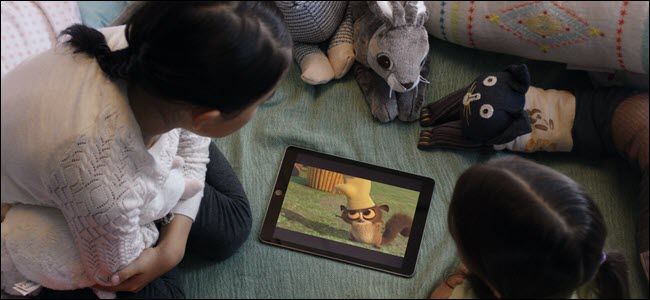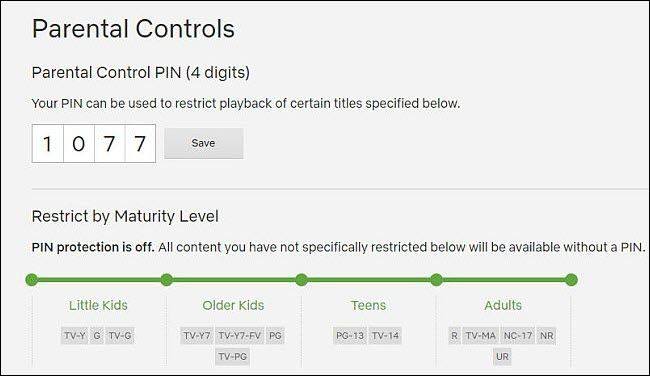Quick Links
Netflix has a parental control problem. You can create "Kids" profiles, but kids can easily escape them. You can set a PIN to block content, but Netflix still bombards kids with mature trailers. Netflix's parental controls need to be better.
Update: Since we originally wrote this article in August 2019, Netflix has added expanded parental controls. You can now lock adult Netflix profiles with a PIN, too.
Kid Profiles Aren't Parental Controls
The fact that Netflix is so easy to share with friends and family is fantastic. Everyone can have an individual profile (your account can have up to five), which means your suggestions won't include Magic School Bus or StoryBots.
And setting your young children up with a kid's profile should keep them from seeing the mature shows. It should, but it won't. Unfortunately, with Netflix's current system, your child can switch to your profile anytime he wants. That's why Netflix calls these "soft controls."
Netflix doesn't lock kids into their profiles. So, if your child already figured out how to switch profiles, he can easily switch from his to yours. The only thing stopping him is the realization he can get to someone else's profile, and that he's not supposed to do that. "Parental security" that relies on the innocence and honesty of a child isn't security at all.
What do you do when your children switch profiles and check out content you don't want them to watch? Unfortunately, right now, you can't keep them out of your profile. The only thing you can do is set a PIN to prevent them from playing that Rated R movie Netflix added last week. But even that is problematic because the PIN system is counterintuitive and doesn't block everything.
PINs Are Counterintuitive
The real parental control feature is the PIN system, which Netflix calls "hard controls." If you set a PIN on your account, you can set Netflix to require it before playing mature content in any profile.
You access Netflix's parental control PIN system from account settings. Any change you make applies to every profile. The first problem, though, is that the PIN system is counterintuitive.
To access the parental controls, you have to go to Netflix's website. You can't access it from an iPad, smartphone, or any other device. If you try, the app points you to the site.
When you access the parental controls, the first step is to provide a four-digit PIN. Choose this carefully, as you have to give it to any friends or family members who use your Netflix account. If you don't feel comfortable handing out your debit card PIN, don't use that.
The green bar in the Parental Controls settings denotes the rating levels that don't require a PIN for access. If you move the bar all the way to the right for maturity, that's not correct. If the green bar is full, parental controls are off. Thankfully, you can also specify specific shows to block.
It might not always be clear when you need to use the PIN, either. According to Netflix, once you allow a show to play, you won't need to input your PIN again until either the next episode changes ratings, or you sign out, switch profiles, or are inactive "for long enough" (Netflix doesn't specify exactly how long "enough" is).
So, just because your child continues to watch the same show doesn't mean you won't have to enter your PIN again. You might have to if a newer episode is rated higher than the previous one.
PINs Don't Prevent Mature Trailers
It's only a matter of time before your children grow curious and switch to your profile. Unfortunately, what they might see is out of your control. Netflix advertises various shows at the top of the page in nearly every app. The advertisement typically includes a trailer video. Scroll down, and you often find additional trailers.
While setting a PIN stops every other trailer from playing, it doesn't stop these Netflix advertisements. They're exempt, and you have no way to stop them. Consider the image above from the Stranger Things trailer. It starts innocently enough: a young boy returns home, and his toy robots start parading out of the room. That's precisely the sort of thing that might catch a small child's attention. It isn't long before the "stranger things" appear, like the monstrous horror in the image above, which would terrify any young child.
"Stranger Things" is really a better-case scenario as it's rated TV-14. Netflix hosts and creates TV-Shows and Movies that are rated TV-Mature and R. Sometimes, it features those shows in these advertisements.
Even if by chance every preview is kid-friendly, Netflix still shows images for every show you can watch. This sometimes includes racy images from mature shows you might not want to your children to see. And again---you can't turn these off, you can't lock them with a PIN, and you can't prevent your child from opening an "adult" profile.
PINs Only Work for One-Child Families
If you have more than one child, you'll find the parental controls cumbersome. If you have kids who are three or four years apart, what you allow your eldest child to watch might differ drastically from what you want your youngest to watch. But Netflix doesn't allow any distinction. When you set a maturity level, it applies to every profile.
You can block everything you wouldn't want your youngest to see and enter your PIN regularly for your oldest child. Or, you can unblock everything you allow your oldest child to watch which unblocks that content for your other kids, too.
You could give your pin to your oldest child, but that gives them access to everything---even mature content. Unfortunately, these cumbersome options only work well for one-child families.
Netflix Should Add PIN-Restricted Profiles
All these problems are solvable with a single solution. Instead of one account-wide PIN and maturity rating that affects all profiles, Netflix should introduce profile level choices and PINs.
Currently, to access the parental controls, you have to provide the account password. That's perfect and should stay as is. Once logged into the parental control app, Netflix should empower you to enforce maturity ratings on a profile-by-profile basis. Little John is 5, so you can set his profile to "little kid." Susie just turned 15, so her profile can graduate to "teen."
To prevent children from hopping into profiles that don't belong to them, Netflix should expand the current PIN system to include multiple PINs for profiles. Anyone set to a Kids profile with a low maturity rating doesn't need a PIN. But you could optionally give a PIN to your teenager, so the younger siblings can't gain access. And each adult profile can have its own PIN.
To override maturity settings on an on-off basis, you could use an approved adult PIN. The current rules concerning re-entering a PIN after a rating switch would still apply.
By moving away from account-wide controls to profile-wide controls, Netflix would exchange a blunt hammer for a scalpel. The company should let you decide who's ready for what, without making the process a lesson in frustration.




